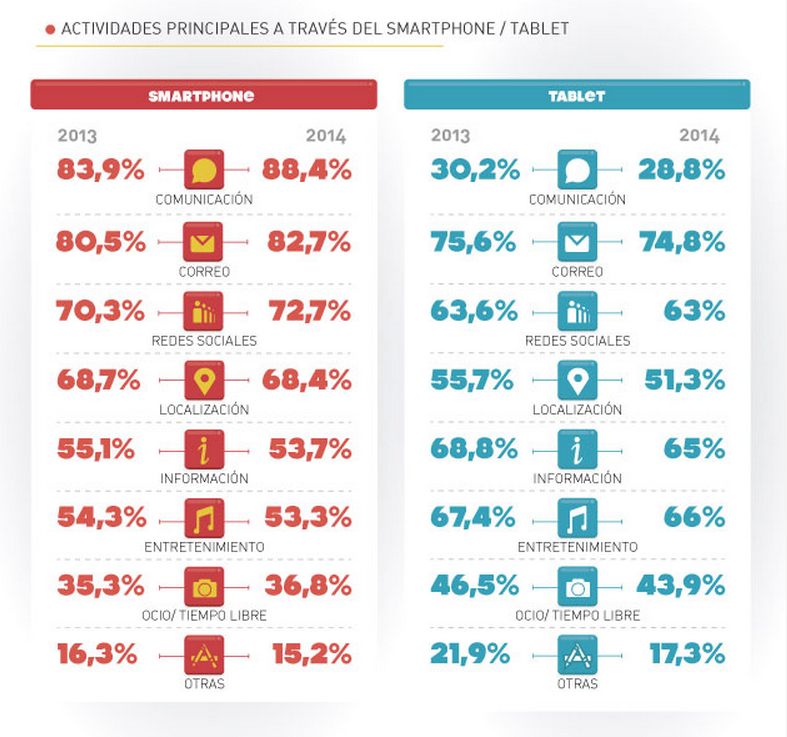The growing use of mobile devices in Spain is a fact. Year after year, data show the growing dependence we have on mobility. Actually, Spain is the European country with greater use of smartphones and mobile devices in general (66% penetration), according to the comScore report “Spain Digital Future in Focus”. This figure almost equals that of the United States, where smartphones have 67% of the market.
These are considerable usage levels of mobile devices, and companies should take them into account when establishing their business strategies to expand their horizons into mCommerce and/or mobile marketing, focused especially in mobile apps. According to The AppDate report that we will discuss later, in Spain there are already over 23 million users who use mobile application actively.
The use of apps in Spain
In general, Spaniards have very well defined habits regarding the use of mobile applications, as they have not changed much since we started having the first mobile phones, although use has been growing year after year. In this sense, according to the latest report from The AppDate, activities related to communication (including, of course, instant messaging applications) continue to be the most popular (88.4%). The ranking of activities performed with mobile devices continues with email management (82.7%), social networks (72.7%), mapping tools (68.4%), information (53.7%), entertainment (53.3%) and leisure (36.8%).

In general, in Spain an average of 3.8 million apps are downloaded each day. In each smartphone there is an average of 39 applications installed, while in tablets the average is of 33 apps. In this regard, it is curious to observe how in the early years of mobility the use of browsers always exceeded the download of apps. However, things have changed and the latest data show a clear increase in the use of apps versus search engines, probably because mobile apps are now better optimized than mobile websites and make good use of features such as geolocation, the push notifications up, etc.
On the other hand, the analysis shows that, at present, 98.5% of the 23 million active users of mobile applications in Spain choose Whatsapp to stay in touch with other people. Undoubtedly, Whatsapp has become the leading platform for mobile communication, not only for people but also for companies, who are using it widely in marketing campaigns with special offers including pictures, text and videos, for creating contests with links to websites, or for sending content with links to landing pages optimized for mobile, among other actions. These campaigns can be segmented by gender, preferences, age, place of residence, and annual income, and even know if users purchase through internet.
Actually, it is interesting to know that 39% of users of apps in Spain are between 25 and 34 years old. The next age range is from 35 to 44, while users between 45 and 55 years old represent a 12%.
From connecting people, to apps connecting objects
In Spain, as well as in the rest of the world, Android has the largest market share in smartphones and tablets, with 60.8% versus the 35% of iOS. Hence, the percentage of apps downloaded by Spaniards according to the operating system of their mobile devices is: 87.5% Android; 8.2% iOS, and 4.1% Windows Phone, says The AppDate report.
Although devices such as smartphones and tablets monopolize the mobile market, we're already seeing the emergence of wearables, which are becoming an emerging market that will define a new channel for mobile content consumption. In fact, economic forecasts offer promising data: according to Business Insider, this new industry could move up to 13 billion dollars in 2018.
For this reason, it is not surprising that, according to The AppDate, many Spanish developers are already trying to conquest the wearables market, trying to develop applications for the so-called smart clothes (Gow, Nuubo or trailBlazer), for bracelets (Neki or eNest), cars (Wikitude Drive, Gasolineras España), smartwatches (Yes.fm, Iberia and Vueling), for the future smart home (Dymotics) and even for shoes (Callaghan), and, of course, for Google Glass (Canal Cocina, Glassters OCR and Running Coach, among many others.)
But not only developers are betting on wearables. Many companies, among them some media, are already taking positions in these new ways of content consumption and have launched the first applications for the new generation of mobile devices. The New York Times, Mashable, CNN or NPR, for example, have apps for Google Glass based on the RSS feeds of their daily news. This is a good strategy, as they are getting a lot of promotion from Google and allows them to take a unique position in the market before the future massive popularization of wearables.












